Ethical Dilemma of Abortion: Analyzing Arguments for and Against
VerifiedAdded on 2020/04/21
|9
|2761
|89
Essay
AI Summary
This essay delves into the ethical dilemma of abortion, presenting a pro-choice perspective within a philosophical framework. The author examines arguments against abortion, including fetal personhood, discrimination, deprivation of rights, uncertainty, religious ideologies, and the breast cancer hypothesis. The essay critiques the concept of assigning personhood to a fetus, emphasizing the lack of consciousness and brain function in early stages of development. Objections are raised against the discrimination argument, and the argument of depriving the fetus of its future. The author proposes that human rights should be assigned based on social recognition rather than innate qualities and argues that the mother's right to choose should be prioritized, particularly in cases where the fetus may have lifelong mental handicaps or when the pregnancy poses risks to the mother's life or well-being. The essay concludes that the ethics of abortion involves complex considerations, advocating for a case-by-case approach where the benefit of the doubt should favor the mother.

Running head: ETHICAL DILEMMA of ABORTION
ETHICAL DILEMMA of ABORTION
-An argument for the abortion case of Deb.
Name of the Student
Name of the University
Author Note:
ETHICAL DILEMMA of ABORTION
-An argument for the abortion case of Deb.
Name of the Student
Name of the University
Author Note:
Paraphrase This Document
Need a fresh take? Get an instant paraphrase of this document with our AI Paraphraser
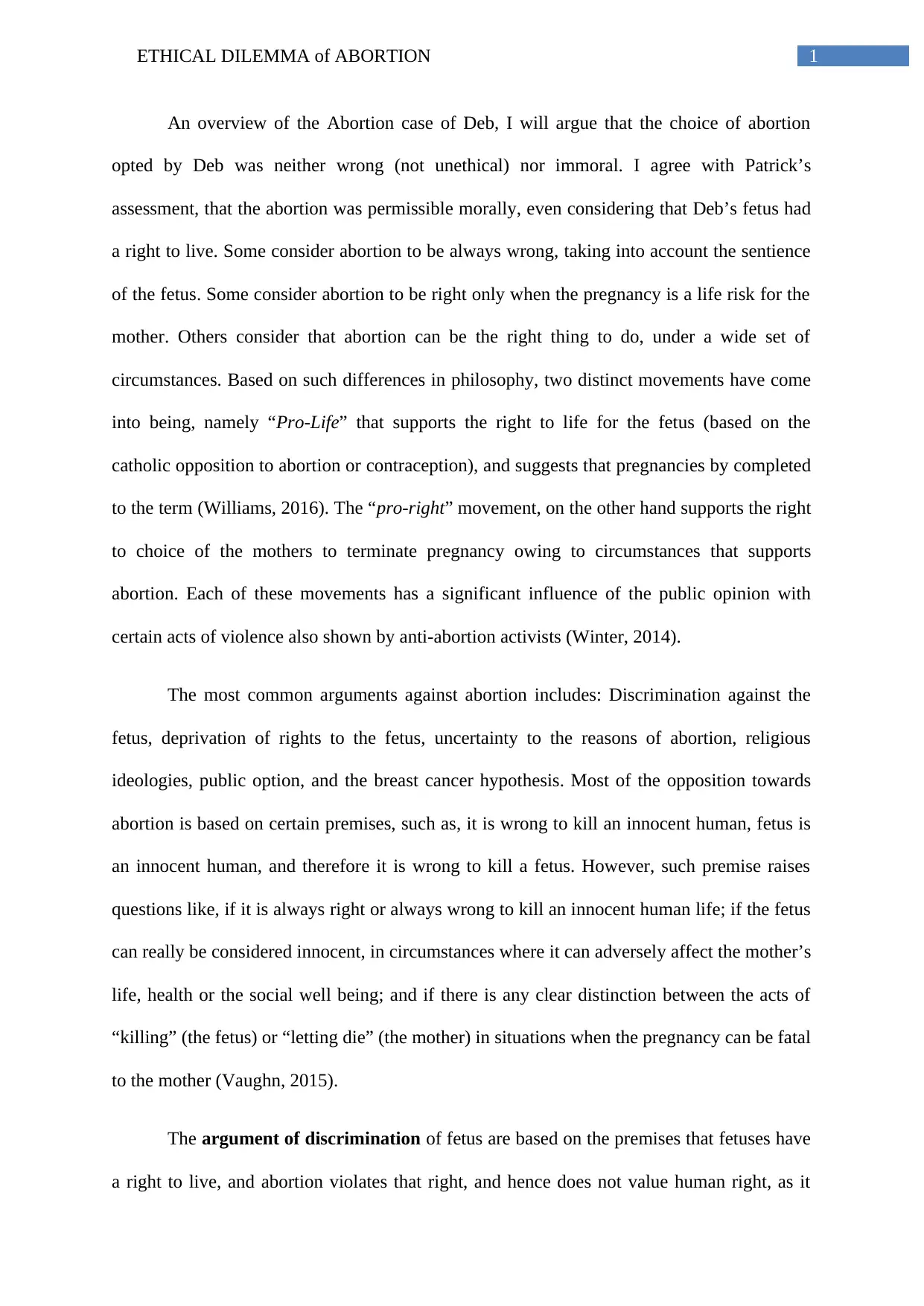
1ETHICAL DILEMMA of ABORTION
An overview of the Abortion case of Deb, I will argue that the choice of abortion
opted by Deb was neither wrong (not unethical) nor immoral. I agree with Patrick’s
assessment, that the abortion was permissible morally, even considering that Deb’s fetus had
a right to live. Some consider abortion to be always wrong, taking into account the sentience
of the fetus. Some consider abortion to be right only when the pregnancy is a life risk for the
mother. Others consider that abortion can be the right thing to do, under a wide set of
circumstances. Based on such differences in philosophy, two distinct movements have come
into being, namely “Pro-Life” that supports the right to life for the fetus (based on the
catholic opposition to abortion or contraception), and suggests that pregnancies by completed
to the term (Williams, 2016). The “pro-right” movement, on the other hand supports the right
to choice of the mothers to terminate pregnancy owing to circumstances that supports
abortion. Each of these movements has a significant influence of the public opinion with
certain acts of violence also shown by anti-abortion activists (Winter, 2014).
The most common arguments against abortion includes: Discrimination against the
fetus, deprivation of rights to the fetus, uncertainty to the reasons of abortion, religious
ideologies, public option, and the breast cancer hypothesis. Most of the opposition towards
abortion is based on certain premises, such as, it is wrong to kill an innocent human, fetus is
an innocent human, and therefore it is wrong to kill a fetus. However, such premise raises
questions like, if it is always right or always wrong to kill an innocent human life; if the fetus
can really be considered innocent, in circumstances where it can adversely affect the mother’s
life, health or the social well being; and if there is any clear distinction between the acts of
“killing” (the fetus) or “letting die” (the mother) in situations when the pregnancy can be fatal
to the mother (Vaughn, 2015).
The argument of discrimination of fetus are based on the premises that fetuses have
a right to live, and abortion violates that right, and hence does not value human right, as it
An overview of the Abortion case of Deb, I will argue that the choice of abortion
opted by Deb was neither wrong (not unethical) nor immoral. I agree with Patrick’s
assessment, that the abortion was permissible morally, even considering that Deb’s fetus had
a right to live. Some consider abortion to be always wrong, taking into account the sentience
of the fetus. Some consider abortion to be right only when the pregnancy is a life risk for the
mother. Others consider that abortion can be the right thing to do, under a wide set of
circumstances. Based on such differences in philosophy, two distinct movements have come
into being, namely “Pro-Life” that supports the right to life for the fetus (based on the
catholic opposition to abortion or contraception), and suggests that pregnancies by completed
to the term (Williams, 2016). The “pro-right” movement, on the other hand supports the right
to choice of the mothers to terminate pregnancy owing to circumstances that supports
abortion. Each of these movements has a significant influence of the public opinion with
certain acts of violence also shown by anti-abortion activists (Winter, 2014).
The most common arguments against abortion includes: Discrimination against the
fetus, deprivation of rights to the fetus, uncertainty to the reasons of abortion, religious
ideologies, public option, and the breast cancer hypothesis. Most of the opposition towards
abortion is based on certain premises, such as, it is wrong to kill an innocent human, fetus is
an innocent human, and therefore it is wrong to kill a fetus. However, such premise raises
questions like, if it is always right or always wrong to kill an innocent human life; if the fetus
can really be considered innocent, in circumstances where it can adversely affect the mother’s
life, health or the social well being; and if there is any clear distinction between the acts of
“killing” (the fetus) or “letting die” (the mother) in situations when the pregnancy can be fatal
to the mother (Vaughn, 2015).
The argument of discrimination of fetus are based on the premises that fetuses have
a right to live, and abortion violates that right, and hence does not value human right, as it
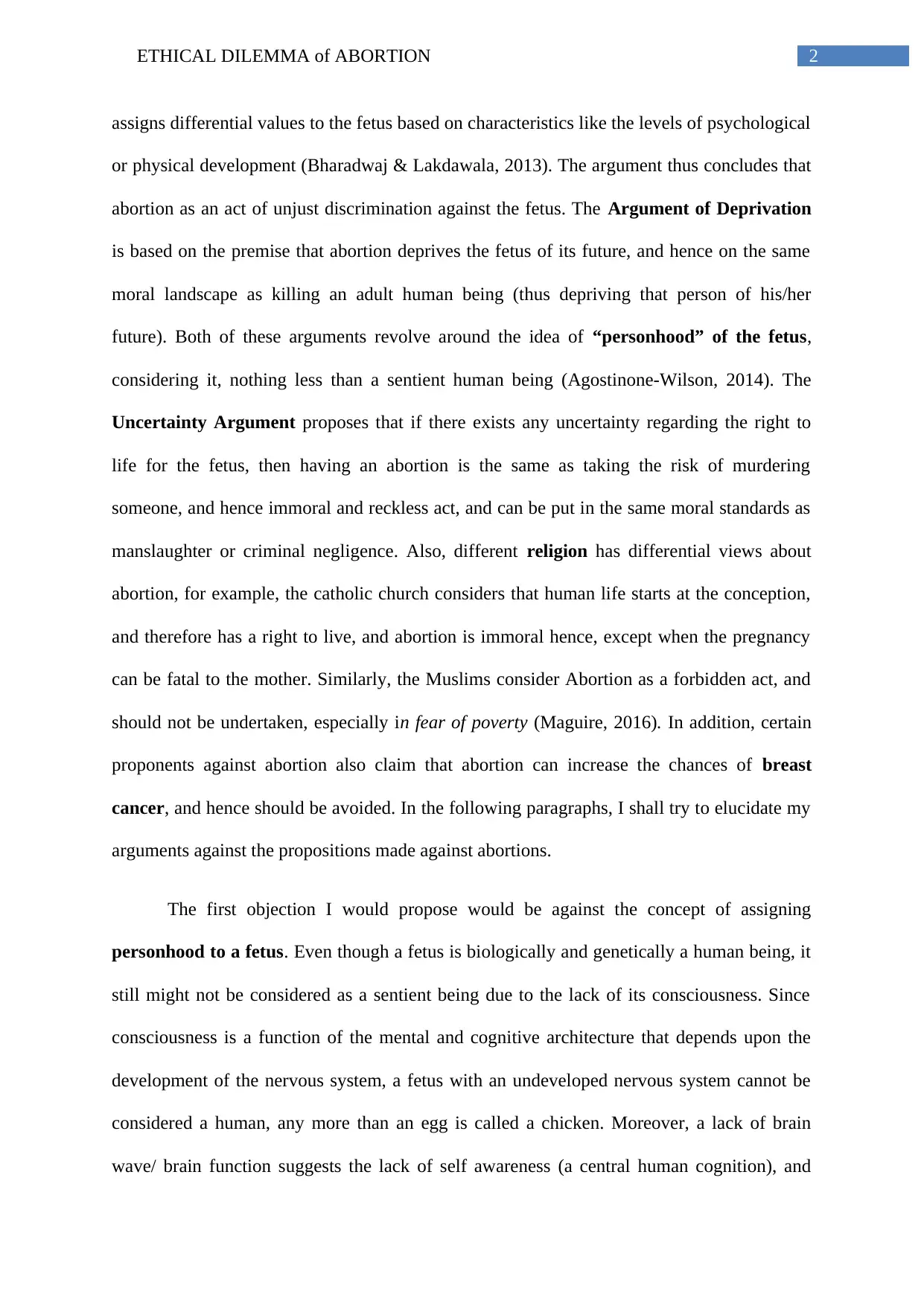
2ETHICAL DILEMMA of ABORTION
assigns differential values to the fetus based on characteristics like the levels of psychological
or physical development (Bharadwaj & Lakdawala, 2013). The argument thus concludes that
abortion as an act of unjust discrimination against the fetus. The Argument of Deprivation
is based on the premise that abortion deprives the fetus of its future, and hence on the same
moral landscape as killing an adult human being (thus depriving that person of his/her
future). Both of these arguments revolve around the idea of “personhood” of the fetus,
considering it, nothing less than a sentient human being (Agostinone-Wilson, 2014). The
Uncertainty Argument proposes that if there exists any uncertainty regarding the right to
life for the fetus, then having an abortion is the same as taking the risk of murdering
someone, and hence immoral and reckless act, and can be put in the same moral standards as
manslaughter or criminal negligence. Also, different religion has differential views about
abortion, for example, the catholic church considers that human life starts at the conception,
and therefore has a right to live, and abortion is immoral hence, except when the pregnancy
can be fatal to the mother. Similarly, the Muslims consider Abortion as a forbidden act, and
should not be undertaken, especially in fear of poverty (Maguire, 2016). In addition, certain
proponents against abortion also claim that abortion can increase the chances of breast
cancer, and hence should be avoided. In the following paragraphs, I shall try to elucidate my
arguments against the propositions made against abortions.
The first objection I would propose would be against the concept of assigning
personhood to a fetus. Even though a fetus is biologically and genetically a human being, it
still might not be considered as a sentient being due to the lack of its consciousness. Since
consciousness is a function of the mental and cognitive architecture that depends upon the
development of the nervous system, a fetus with an undeveloped nervous system cannot be
considered a human, any more than an egg is called a chicken. Moreover, a lack of brain
wave/ brain function suggests the lack of self awareness (a central human cognition), and
assigns differential values to the fetus based on characteristics like the levels of psychological
or physical development (Bharadwaj & Lakdawala, 2013). The argument thus concludes that
abortion as an act of unjust discrimination against the fetus. The Argument of Deprivation
is based on the premise that abortion deprives the fetus of its future, and hence on the same
moral landscape as killing an adult human being (thus depriving that person of his/her
future). Both of these arguments revolve around the idea of “personhood” of the fetus,
considering it, nothing less than a sentient human being (Agostinone-Wilson, 2014). The
Uncertainty Argument proposes that if there exists any uncertainty regarding the right to
life for the fetus, then having an abortion is the same as taking the risk of murdering
someone, and hence immoral and reckless act, and can be put in the same moral standards as
manslaughter or criminal negligence. Also, different religion has differential views about
abortion, for example, the catholic church considers that human life starts at the conception,
and therefore has a right to live, and abortion is immoral hence, except when the pregnancy
can be fatal to the mother. Similarly, the Muslims consider Abortion as a forbidden act, and
should not be undertaken, especially in fear of poverty (Maguire, 2016). In addition, certain
proponents against abortion also claim that abortion can increase the chances of breast
cancer, and hence should be avoided. In the following paragraphs, I shall try to elucidate my
arguments against the propositions made against abortions.
The first objection I would propose would be against the concept of assigning
personhood to a fetus. Even though a fetus is biologically and genetically a human being, it
still might not be considered as a sentient being due to the lack of its consciousness. Since
consciousness is a function of the mental and cognitive architecture that depends upon the
development of the nervous system, a fetus with an undeveloped nervous system cannot be
considered a human, any more than an egg is called a chicken. Moreover, a lack of brain
wave/ brain function suggests the lack of self awareness (a central human cognition), and
⊘ This is a preview!⊘
Do you want full access?
Subscribe today to unlock all pages.

Trusted by 1+ million students worldwide
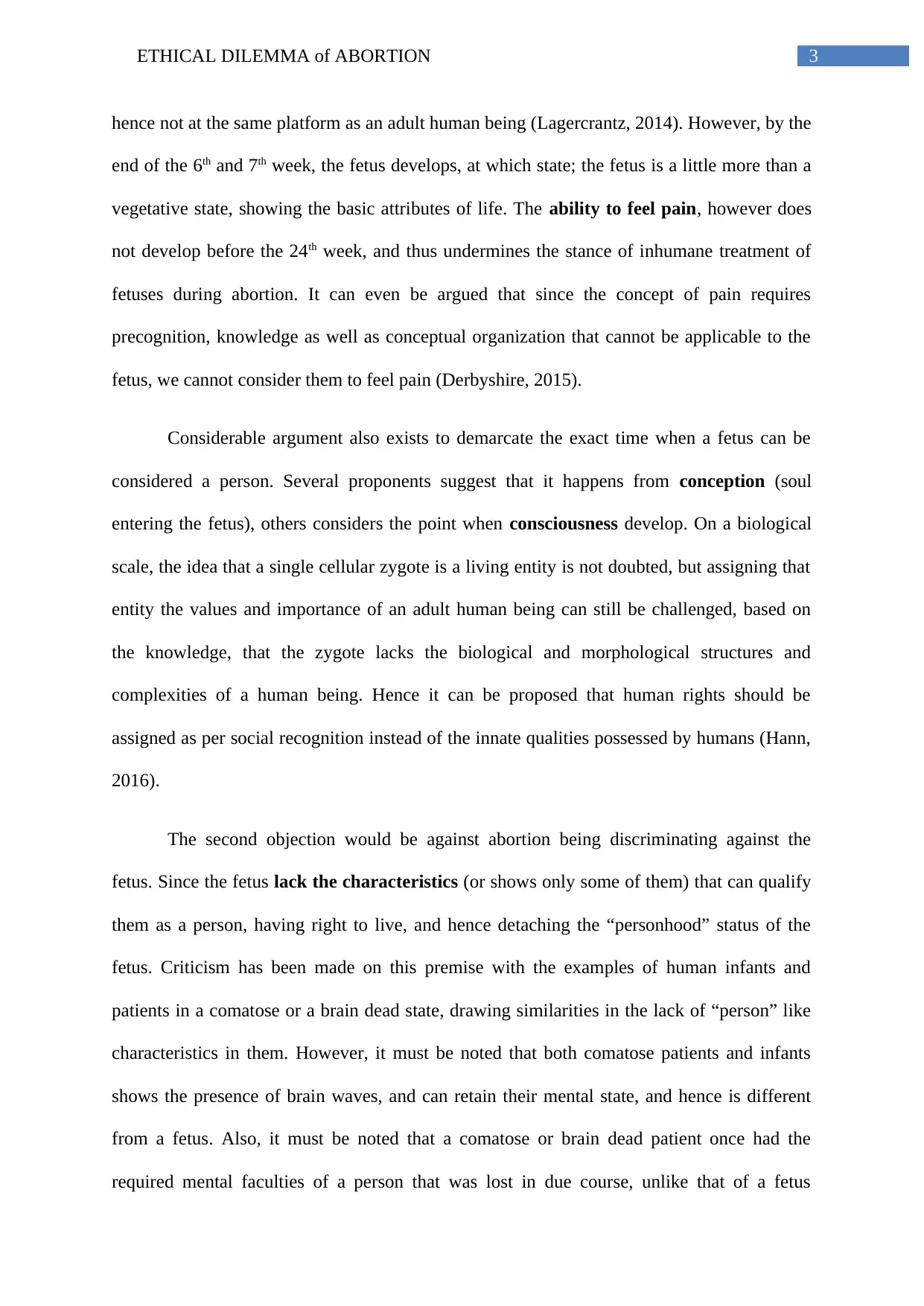
3ETHICAL DILEMMA of ABORTION
hence not at the same platform as an adult human being (Lagercrantz, 2014). However, by the
end of the 6th and 7th week, the fetus develops, at which state; the fetus is a little more than a
vegetative state, showing the basic attributes of life. The ability to feel pain, however does
not develop before the 24th week, and thus undermines the stance of inhumane treatment of
fetuses during abortion. It can even be argued that since the concept of pain requires
precognition, knowledge as well as conceptual organization that cannot be applicable to the
fetus, we cannot consider them to feel pain (Derbyshire, 2015).
Considerable argument also exists to demarcate the exact time when a fetus can be
considered a person. Several proponents suggest that it happens from conception (soul
entering the fetus), others considers the point when consciousness develop. On a biological
scale, the idea that a single cellular zygote is a living entity is not doubted, but assigning that
entity the values and importance of an adult human being can still be challenged, based on
the knowledge, that the zygote lacks the biological and morphological structures and
complexities of a human being. Hence it can be proposed that human rights should be
assigned as per social recognition instead of the innate qualities possessed by humans (Hann,
2016).
The second objection would be against abortion being discriminating against the
fetus. Since the fetus lack the characteristics (or shows only some of them) that can qualify
them as a person, having right to live, and hence detaching the “personhood” status of the
fetus. Criticism has been made on this premise with the examples of human infants and
patients in a comatose or a brain dead state, drawing similarities in the lack of “person” like
characteristics in them. However, it must be noted that both comatose patients and infants
shows the presence of brain waves, and can retain their mental state, and hence is different
from a fetus. Also, it must be noted that a comatose or brain dead patient once had the
required mental faculties of a person that was lost in due course, unlike that of a fetus
hence not at the same platform as an adult human being (Lagercrantz, 2014). However, by the
end of the 6th and 7th week, the fetus develops, at which state; the fetus is a little more than a
vegetative state, showing the basic attributes of life. The ability to feel pain, however does
not develop before the 24th week, and thus undermines the stance of inhumane treatment of
fetuses during abortion. It can even be argued that since the concept of pain requires
precognition, knowledge as well as conceptual organization that cannot be applicable to the
fetus, we cannot consider them to feel pain (Derbyshire, 2015).
Considerable argument also exists to demarcate the exact time when a fetus can be
considered a person. Several proponents suggest that it happens from conception (soul
entering the fetus), others considers the point when consciousness develop. On a biological
scale, the idea that a single cellular zygote is a living entity is not doubted, but assigning that
entity the values and importance of an adult human being can still be challenged, based on
the knowledge, that the zygote lacks the biological and morphological structures and
complexities of a human being. Hence it can be proposed that human rights should be
assigned as per social recognition instead of the innate qualities possessed by humans (Hann,
2016).
The second objection would be against abortion being discriminating against the
fetus. Since the fetus lack the characteristics (or shows only some of them) that can qualify
them as a person, having right to live, and hence detaching the “personhood” status of the
fetus. Criticism has been made on this premise with the examples of human infants and
patients in a comatose or a brain dead state, drawing similarities in the lack of “person” like
characteristics in them. However, it must be noted that both comatose patients and infants
shows the presence of brain waves, and can retain their mental state, and hence is different
from a fetus. Also, it must be noted that a comatose or brain dead patient once had the
required mental faculties of a person that was lost in due course, unlike that of a fetus
Paraphrase This Document
Need a fresh take? Get an instant paraphrase of this document with our AI Paraphraser
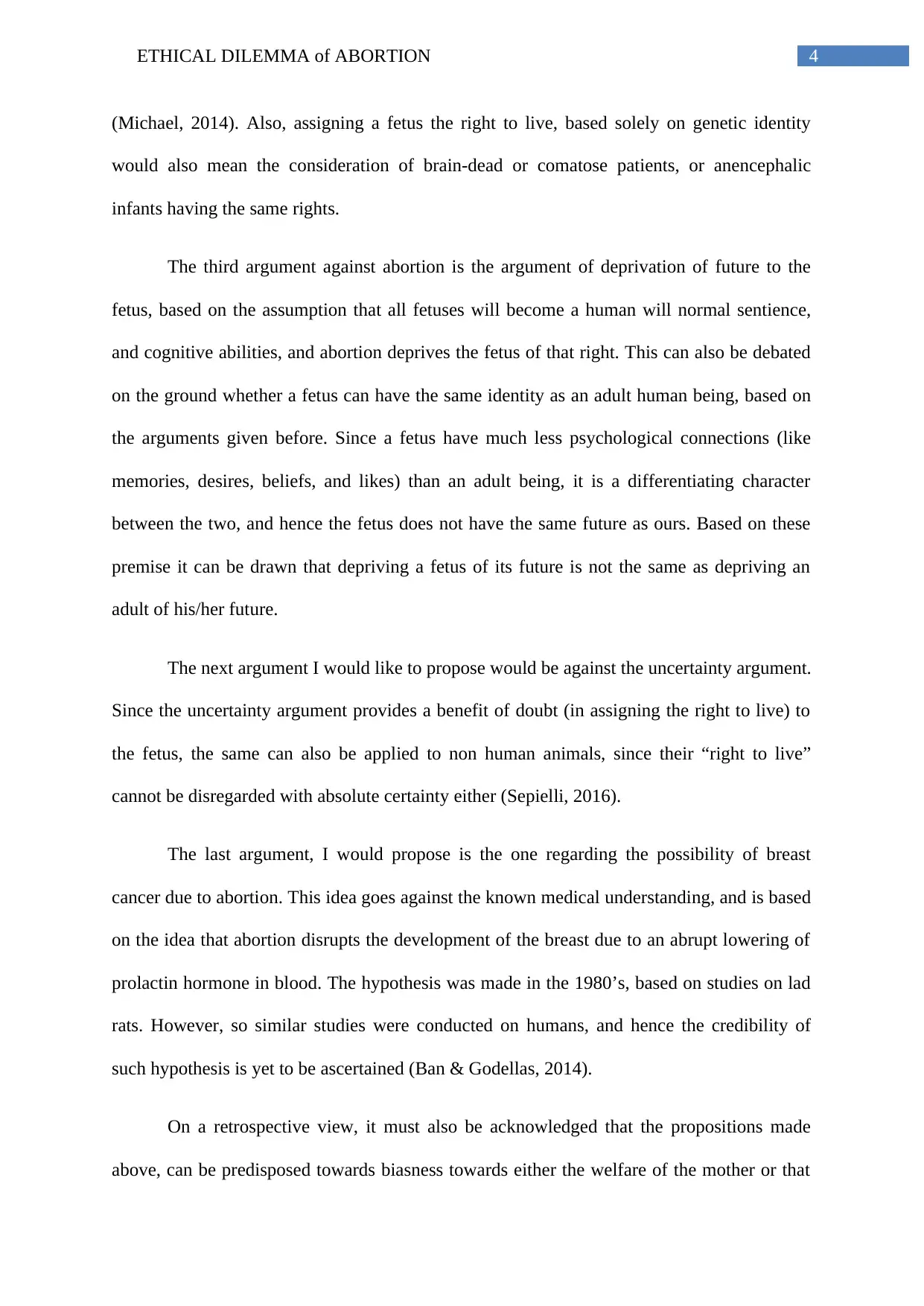
4ETHICAL DILEMMA of ABORTION
(Michael, 2014). Also, assigning a fetus the right to live, based solely on genetic identity
would also mean the consideration of brain-dead or comatose patients, or anencephalic
infants having the same rights.
The third argument against abortion is the argument of deprivation of future to the
fetus, based on the assumption that all fetuses will become a human will normal sentience,
and cognitive abilities, and abortion deprives the fetus of that right. This can also be debated
on the ground whether a fetus can have the same identity as an adult human being, based on
the arguments given before. Since a fetus have much less psychological connections (like
memories, desires, beliefs, and likes) than an adult being, it is a differentiating character
between the two, and hence the fetus does not have the same future as ours. Based on these
premise it can be drawn that depriving a fetus of its future is not the same as depriving an
adult of his/her future.
The next argument I would like to propose would be against the uncertainty argument.
Since the uncertainty argument provides a benefit of doubt (in assigning the right to live) to
the fetus, the same can also be applied to non human animals, since their “right to live”
cannot be disregarded with absolute certainty either (Sepielli, 2016).
The last argument, I would propose is the one regarding the possibility of breast
cancer due to abortion. This idea goes against the known medical understanding, and is based
on the idea that abortion disrupts the development of the breast due to an abrupt lowering of
prolactin hormone in blood. The hypothesis was made in the 1980’s, based on studies on lad
rats. However, so similar studies were conducted on humans, and hence the credibility of
such hypothesis is yet to be ascertained (Ban & Godellas, 2014).
On a retrospective view, it must also be acknowledged that the propositions made
above, can be predisposed towards biasness towards either the welfare of the mother or that
(Michael, 2014). Also, assigning a fetus the right to live, based solely on genetic identity
would also mean the consideration of brain-dead or comatose patients, or anencephalic
infants having the same rights.
The third argument against abortion is the argument of deprivation of future to the
fetus, based on the assumption that all fetuses will become a human will normal sentience,
and cognitive abilities, and abortion deprives the fetus of that right. This can also be debated
on the ground whether a fetus can have the same identity as an adult human being, based on
the arguments given before. Since a fetus have much less psychological connections (like
memories, desires, beliefs, and likes) than an adult being, it is a differentiating character
between the two, and hence the fetus does not have the same future as ours. Based on these
premise it can be drawn that depriving a fetus of its future is not the same as depriving an
adult of his/her future.
The next argument I would like to propose would be against the uncertainty argument.
Since the uncertainty argument provides a benefit of doubt (in assigning the right to live) to
the fetus, the same can also be applied to non human animals, since their “right to live”
cannot be disregarded with absolute certainty either (Sepielli, 2016).
The last argument, I would propose is the one regarding the possibility of breast
cancer due to abortion. This idea goes against the known medical understanding, and is based
on the idea that abortion disrupts the development of the breast due to an abrupt lowering of
prolactin hormone in blood. The hypothesis was made in the 1980’s, based on studies on lad
rats. However, so similar studies were conducted on humans, and hence the credibility of
such hypothesis is yet to be ascertained (Ban & Godellas, 2014).
On a retrospective view, it must also be acknowledged that the propositions made
above, can be predisposed towards biasness towards either the welfare of the mother or that
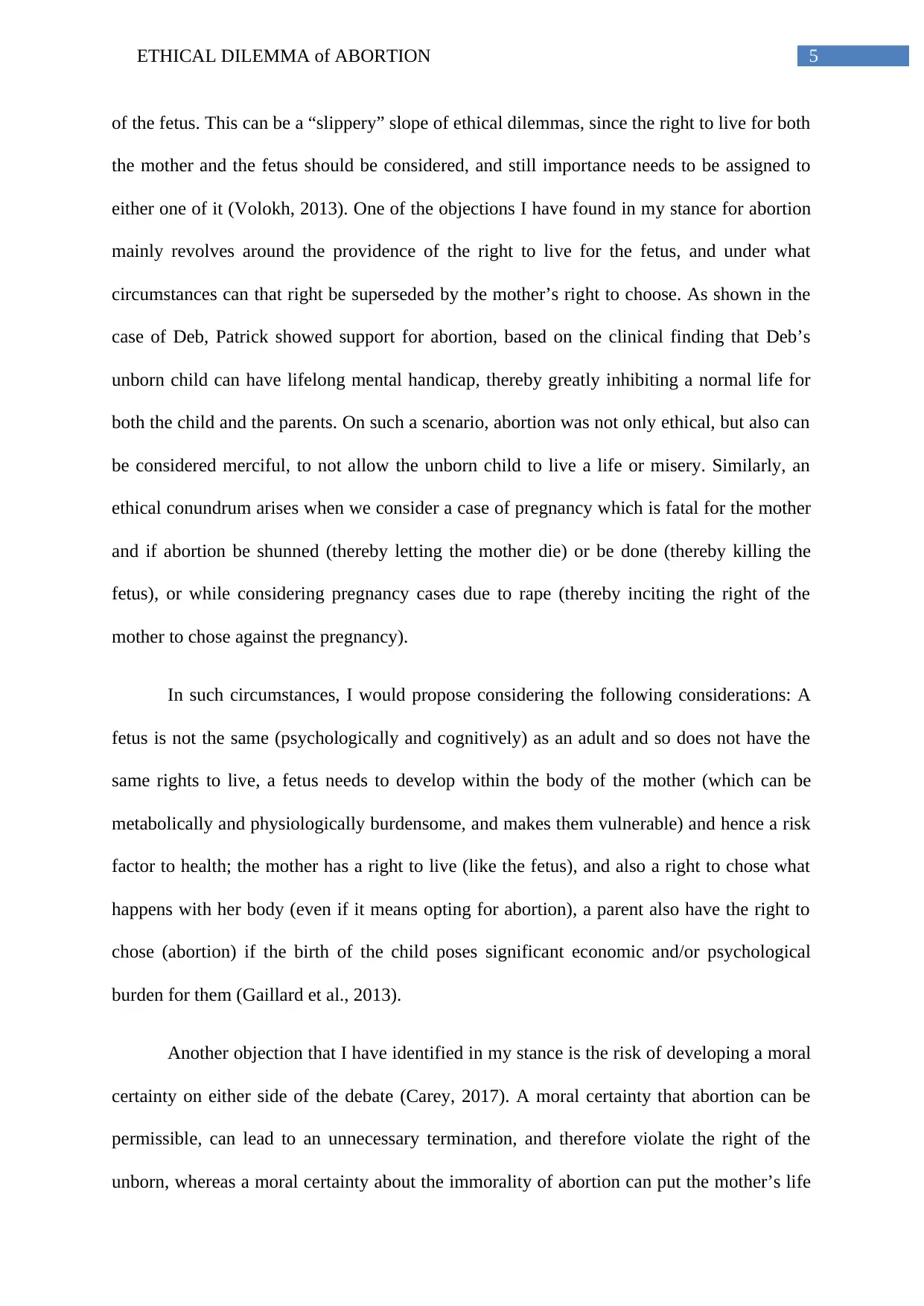
5ETHICAL DILEMMA of ABORTION
of the fetus. This can be a “slippery” slope of ethical dilemmas, since the right to live for both
the mother and the fetus should be considered, and still importance needs to be assigned to
either one of it (Volokh, 2013). One of the objections I have found in my stance for abortion
mainly revolves around the providence of the right to live for the fetus, and under what
circumstances can that right be superseded by the mother’s right to choose. As shown in the
case of Deb, Patrick showed support for abortion, based on the clinical finding that Deb’s
unborn child can have lifelong mental handicap, thereby greatly inhibiting a normal life for
both the child and the parents. On such a scenario, abortion was not only ethical, but also can
be considered merciful, to not allow the unborn child to live a life or misery. Similarly, an
ethical conundrum arises when we consider a case of pregnancy which is fatal for the mother
and if abortion be shunned (thereby letting the mother die) or be done (thereby killing the
fetus), or while considering pregnancy cases due to rape (thereby inciting the right of the
mother to chose against the pregnancy).
In such circumstances, I would propose considering the following considerations: A
fetus is not the same (psychologically and cognitively) as an adult and so does not have the
same rights to live, a fetus needs to develop within the body of the mother (which can be
metabolically and physiologically burdensome, and makes them vulnerable) and hence a risk
factor to health; the mother has a right to live (like the fetus), and also a right to chose what
happens with her body (even if it means opting for abortion), a parent also have the right to
chose (abortion) if the birth of the child poses significant economic and/or psychological
burden for them (Gaillard et al., 2013).
Another objection that I have identified in my stance is the risk of developing a moral
certainty on either side of the debate (Carey, 2017). A moral certainty that abortion can be
permissible, can lead to an unnecessary termination, and therefore violate the right of the
unborn, whereas a moral certainty about the immorality of abortion can put the mother’s life
of the fetus. This can be a “slippery” slope of ethical dilemmas, since the right to live for both
the mother and the fetus should be considered, and still importance needs to be assigned to
either one of it (Volokh, 2013). One of the objections I have found in my stance for abortion
mainly revolves around the providence of the right to live for the fetus, and under what
circumstances can that right be superseded by the mother’s right to choose. As shown in the
case of Deb, Patrick showed support for abortion, based on the clinical finding that Deb’s
unborn child can have lifelong mental handicap, thereby greatly inhibiting a normal life for
both the child and the parents. On such a scenario, abortion was not only ethical, but also can
be considered merciful, to not allow the unborn child to live a life or misery. Similarly, an
ethical conundrum arises when we consider a case of pregnancy which is fatal for the mother
and if abortion be shunned (thereby letting the mother die) or be done (thereby killing the
fetus), or while considering pregnancy cases due to rape (thereby inciting the right of the
mother to chose against the pregnancy).
In such circumstances, I would propose considering the following considerations: A
fetus is not the same (psychologically and cognitively) as an adult and so does not have the
same rights to live, a fetus needs to develop within the body of the mother (which can be
metabolically and physiologically burdensome, and makes them vulnerable) and hence a risk
factor to health; the mother has a right to live (like the fetus), and also a right to chose what
happens with her body (even if it means opting for abortion), a parent also have the right to
chose (abortion) if the birth of the child poses significant economic and/or psychological
burden for them (Gaillard et al., 2013).
Another objection that I have identified in my stance is the risk of developing a moral
certainty on either side of the debate (Carey, 2017). A moral certainty that abortion can be
permissible, can lead to an unnecessary termination, and therefore violate the right of the
unborn, whereas a moral certainty about the immorality of abortion can put the mother’s life
⊘ This is a preview!⊘
Do you want full access?
Subscribe today to unlock all pages.

Trusted by 1+ million students worldwide
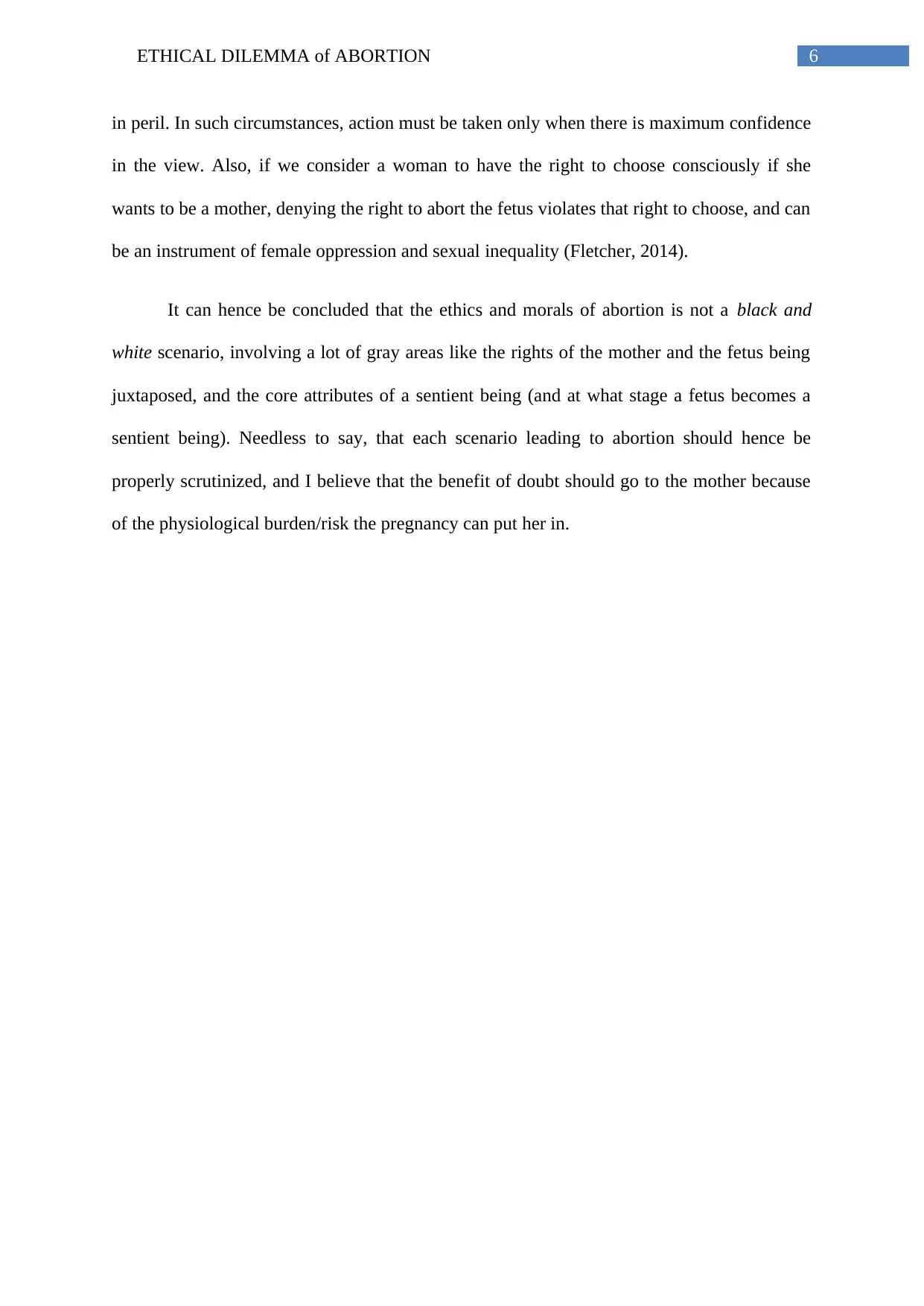
6ETHICAL DILEMMA of ABORTION
in peril. In such circumstances, action must be taken only when there is maximum confidence
in the view. Also, if we consider a woman to have the right to choose consciously if she
wants to be a mother, denying the right to abort the fetus violates that right to choose, and can
be an instrument of female oppression and sexual inequality (Fletcher, 2014).
It can hence be concluded that the ethics and morals of abortion is not a black and
white scenario, involving a lot of gray areas like the rights of the mother and the fetus being
juxtaposed, and the core attributes of a sentient being (and at what stage a fetus becomes a
sentient being). Needless to say, that each scenario leading to abortion should hence be
properly scrutinized, and I believe that the benefit of doubt should go to the mother because
of the physiological burden/risk the pregnancy can put her in.
in peril. In such circumstances, action must be taken only when there is maximum confidence
in the view. Also, if we consider a woman to have the right to choose consciously if she
wants to be a mother, denying the right to abort the fetus violates that right to choose, and can
be an instrument of female oppression and sexual inequality (Fletcher, 2014).
It can hence be concluded that the ethics and morals of abortion is not a black and
white scenario, involving a lot of gray areas like the rights of the mother and the fetus being
juxtaposed, and the core attributes of a sentient being (and at what stage a fetus becomes a
sentient being). Needless to say, that each scenario leading to abortion should hence be
properly scrutinized, and I believe that the benefit of doubt should go to the mother because
of the physiological burden/risk the pregnancy can put her in.
Paraphrase This Document
Need a fresh take? Get an instant paraphrase of this document with our AI Paraphraser
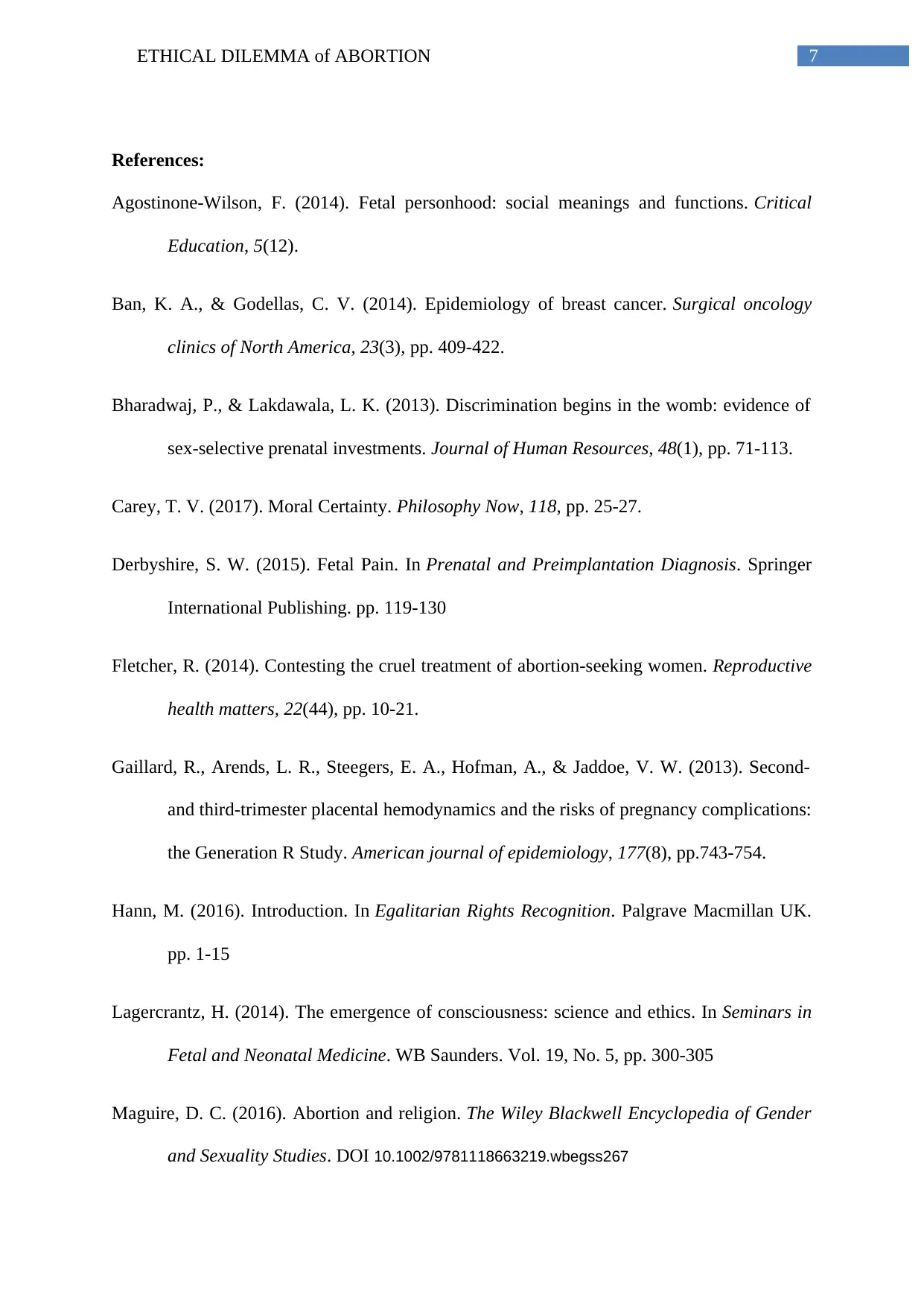
7ETHICAL DILEMMA of ABORTION
References:
Agostinone-Wilson, F. (2014). Fetal personhood: social meanings and functions. Critical
Education, 5(12).
Ban, K. A., & Godellas, C. V. (2014). Epidemiology of breast cancer. Surgical oncology
clinics of North America, 23(3), pp. 409-422.
Bharadwaj, P., & Lakdawala, L. K. (2013). Discrimination begins in the womb: evidence of
sex-selective prenatal investments. Journal of Human Resources, 48(1), pp. 71-113.
Carey, T. V. (2017). Moral Certainty. Philosophy Now, 118, pp. 25-27.
Derbyshire, S. W. (2015). Fetal Pain. In Prenatal and Preimplantation Diagnosis. Springer
International Publishing. pp. 119-130
Fletcher, R. (2014). Contesting the cruel treatment of abortion-seeking women. Reproductive
health matters, 22(44), pp. 10-21.
Gaillard, R., Arends, L. R., Steegers, E. A., Hofman, A., & Jaddoe, V. W. (2013). Second-
and third-trimester placental hemodynamics and the risks of pregnancy complications:
the Generation R Study. American journal of epidemiology, 177(8), pp.743-754.
Hann, M. (2016). Introduction. In Egalitarian Rights Recognition. Palgrave Macmillan UK.
pp. 1-15
Lagercrantz, H. (2014). The emergence of consciousness: science and ethics. In Seminars in
Fetal and Neonatal Medicine. WB Saunders. Vol. 19, No. 5, pp. 300-305
Maguire, D. C. (2016). Abortion and religion. The Wiley Blackwell Encyclopedia of Gender
and Sexuality Studies. DOI 10.1002/9781118663219.wbegss267
References:
Agostinone-Wilson, F. (2014). Fetal personhood: social meanings and functions. Critical
Education, 5(12).
Ban, K. A., & Godellas, C. V. (2014). Epidemiology of breast cancer. Surgical oncology
clinics of North America, 23(3), pp. 409-422.
Bharadwaj, P., & Lakdawala, L. K. (2013). Discrimination begins in the womb: evidence of
sex-selective prenatal investments. Journal of Human Resources, 48(1), pp. 71-113.
Carey, T. V. (2017). Moral Certainty. Philosophy Now, 118, pp. 25-27.
Derbyshire, S. W. (2015). Fetal Pain. In Prenatal and Preimplantation Diagnosis. Springer
International Publishing. pp. 119-130
Fletcher, R. (2014). Contesting the cruel treatment of abortion-seeking women. Reproductive
health matters, 22(44), pp. 10-21.
Gaillard, R., Arends, L. R., Steegers, E. A., Hofman, A., & Jaddoe, V. W. (2013). Second-
and third-trimester placental hemodynamics and the risks of pregnancy complications:
the Generation R Study. American journal of epidemiology, 177(8), pp.743-754.
Hann, M. (2016). Introduction. In Egalitarian Rights Recognition. Palgrave Macmillan UK.
pp. 1-15
Lagercrantz, H. (2014). The emergence of consciousness: science and ethics. In Seminars in
Fetal and Neonatal Medicine. WB Saunders. Vol. 19, No. 5, pp. 300-305
Maguire, D. C. (2016). Abortion and religion. The Wiley Blackwell Encyclopedia of Gender
and Sexuality Studies. DOI 10.1002/9781118663219.wbegss267
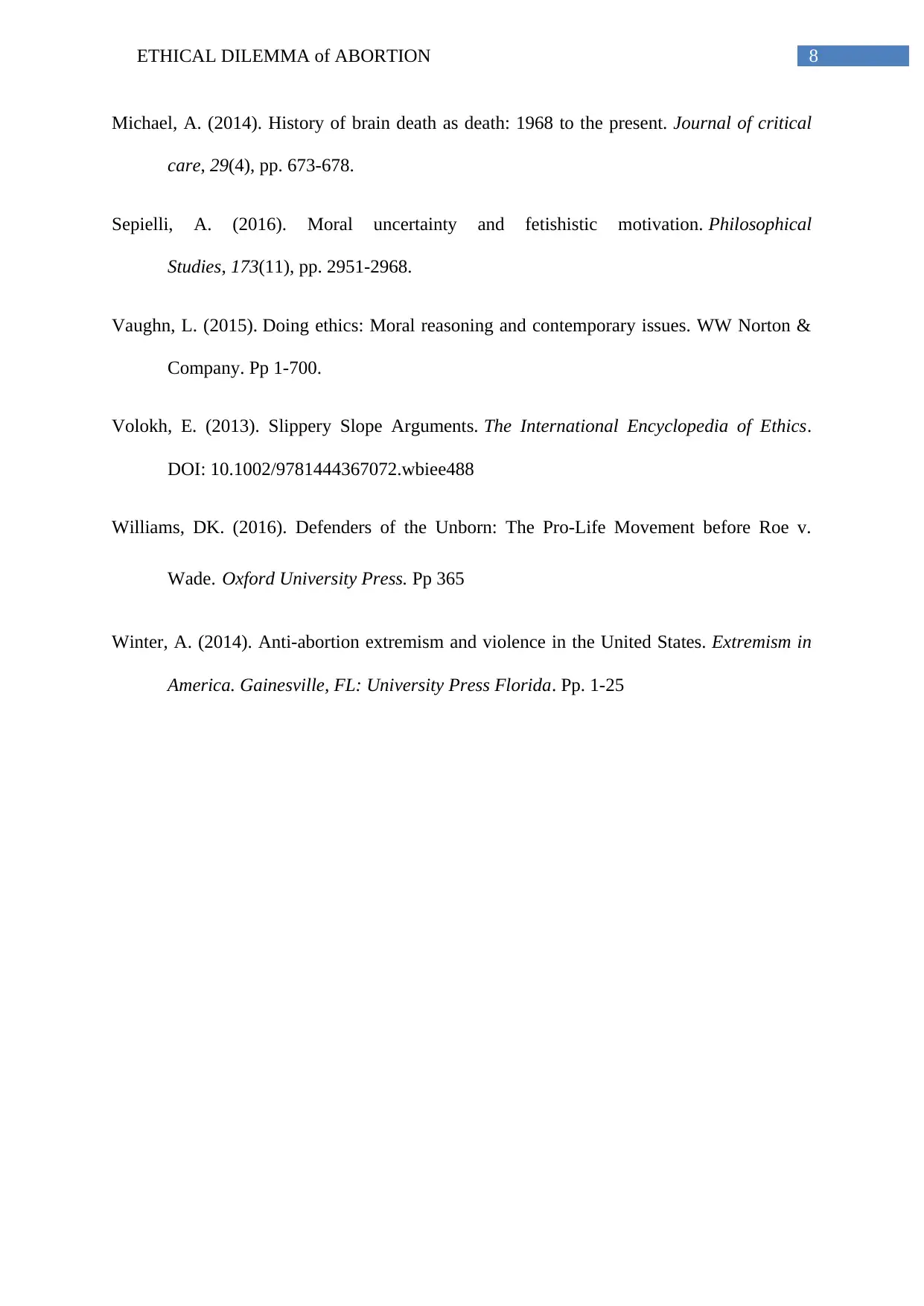
8ETHICAL DILEMMA of ABORTION
Michael, A. (2014). History of brain death as death: 1968 to the present. Journal of critical
care, 29(4), pp. 673-678.
Sepielli, A. (2016). Moral uncertainty and fetishistic motivation. Philosophical
Studies, 173(11), pp. 2951-2968.
Vaughn, L. (2015). Doing ethics: Moral reasoning and contemporary issues. WW Norton &
Company. Pp 1-700.
Volokh, E. (2013). Slippery Slope Arguments. The International Encyclopedia of Ethics.
DOI: 10.1002/9781444367072.wbiee488
Williams, DK. (2016). Defenders of the Unborn: The Pro-Life Movement before Roe v.
Wade. Oxford University Press. Pp 365
Winter, A. (2014). Anti-abortion extremism and violence in the United States. Extremism in
America. Gainesville, FL: University Press Florida. Pp. 1-25
Michael, A. (2014). History of brain death as death: 1968 to the present. Journal of critical
care, 29(4), pp. 673-678.
Sepielli, A. (2016). Moral uncertainty and fetishistic motivation. Philosophical
Studies, 173(11), pp. 2951-2968.
Vaughn, L. (2015). Doing ethics: Moral reasoning and contemporary issues. WW Norton &
Company. Pp 1-700.
Volokh, E. (2013). Slippery Slope Arguments. The International Encyclopedia of Ethics.
DOI: 10.1002/9781444367072.wbiee488
Williams, DK. (2016). Defenders of the Unborn: The Pro-Life Movement before Roe v.
Wade. Oxford University Press. Pp 365
Winter, A. (2014). Anti-abortion extremism and violence in the United States. Extremism in
America. Gainesville, FL: University Press Florida. Pp. 1-25
⊘ This is a preview!⊘
Do you want full access?
Subscribe today to unlock all pages.

Trusted by 1+ million students worldwide
1 out of 9
Related Documents
Your All-in-One AI-Powered Toolkit for Academic Success.
+13062052269
info@desklib.com
Available 24*7 on WhatsApp / Email
![[object Object]](/_next/static/media/star-bottom.7253800d.svg)
Unlock your academic potential
Copyright © 2020–2025 A2Z Services. All Rights Reserved. Developed and managed by ZUCOL.





